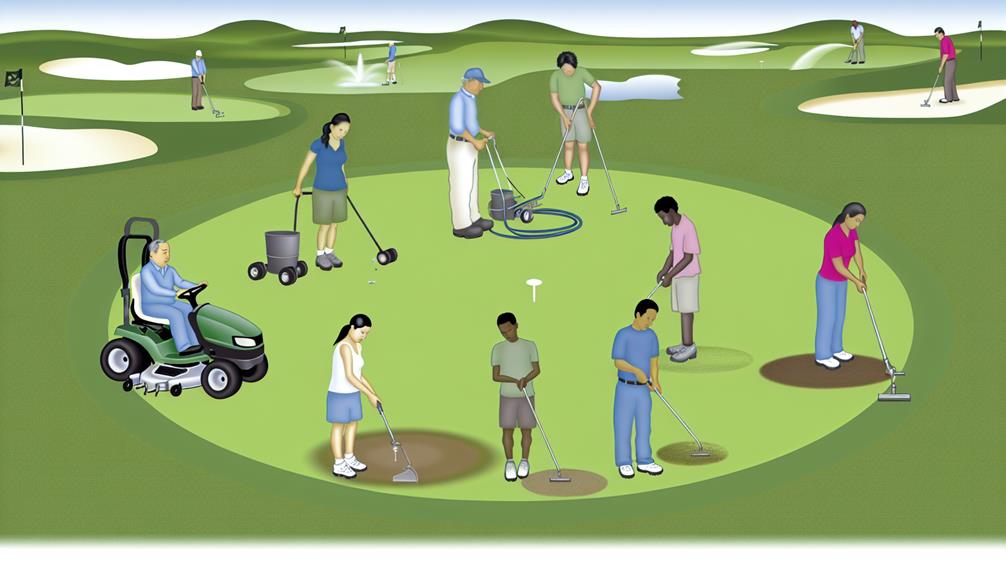Keeping a golf putting green in top shape isn't a walk in the park; it's a task that requires skill, patience, and a keen understanding of turf management.
You've got to be in the know about the essential tools and techniques, the daily and seasonal maintenance strategies, and how to tackle common problems.
But don't worry, this isn't a solo journey. We're here to guide you through the ins and outs and provide you with seven indispensable tips that'll help you maintain a professional putting green.
Intrigued? Stick around, there's much to learn.
Understanding Putting Green Basics
To effectively maintain your golf putting green, it's imperative that you first grasp the basics of its structure and function. The green construction is an amalgamation of various elements including the soil, grass type, and the underlying layer of sand or gravel for drainage. Your understanding of these components shapes your upkeep strategies and directly influences your putting techniques.
The chosen grass for your green should ideally be bentgrass or bermudagrass, known for their smooth texture and resistance to foot traffic. These grasses also maintain a consistent ball roll, critical to efficient putting techniques. The soil composition should ideally be sandy to promote better drainage and prevent water pooling.
Your green's surface should be flat with subtle contours to challenge and improve your putting techniques. Regular aeration, fertilization, and mowing are also crucial to maintain a healthy green.
Understanding green construction and adjusting your putting techniques accordingly is essential. It's not just about maintaining the aesthetic appeal but ensuring that your green serves its functional purpose. Remember, the upkeep of your putting green is a testament to your commitment to the sport.
Essential Tools for Maintenance
Equipping yourself with the right tools is a crucial step in maintaining your golf putting green effectively. But first, you'll need a tool selection guide to help you identify the right equipment.
Generally, you'll need a hole cutter, a moisture meter, a lawn mower, and a turf brush. A hole cutter ensures the holes on your green are perfectly round and of the correct size. The moisture meter helps you maintain the right moisture levels, while the lawn mower and turf brush keep the grass trim and neat.
When it comes to maintenance equipment storage, it's essential to keep your tools clean and in good condition. After each use, clean your tools to remove dirt and grass. Store them in a dry, cool place to prevent rusting and damage. Regularly inspect your tools for any wear and tear and replace or repair them as needed.
Daily Upkeep Strategies
Having the right tools and keeping them in good condition is only half the battle; you also need to know how to use them effectively for daily maintenance of your golf putting green. Upkeep scheduling is paramount. Establish a routine, ensuring tasks like mowing, aerating, and topdressing are performed regularly. This consistent care won't only keep your green looking its best, but also ensure optimal playing conditions.
Irrigation practices are another critical aspect of daily upkeep. You must water your putting green appropriately to maintain its health and resilience. Remember, overwatering can be just as detrimental as underwatering, leading to issues such as disease and poor root development. It's best to water deeply and infrequently, allowing the soil to dry out between watering sessions.
Lastly, monitor your green daily. Look out for signs of disease or pest infestations, and act promptly to remedy any issues. A little time each day can prevent bigger problems down the line.
Seasonal Care Techniques
As the seasons shift, your putting green's care routine needs to adapt to the changing weather conditions and growth patterns. Winter preparation is crucial to ensure the longevity of your green. You should mow your putting green one last time before temperatures drop below freezing, then apply a winter fertilizer to nourish the grass during the colder months. Also, consider covering your green with a protective tarp to shield it from harsh winter elements.
When spring arrives, it's time for rejuvenation. Start by carefully removing any protective coverings and inspecting your green for any winter damage. Next, rake the surface lightly to remove any debris and aerate if necessary to allow oxygen, water, and nutrients to penetrate the soil. Apply a spring fertilizer to kick-start growth and encourage a lush, healthy green. Regular mowing can resume once the grass begins to show signs of renewed growth.
Dealing With Common Problems
While maintaining your golf putting green through the seasons can ensure its health, you're bound to encounter specific issues that need immediate attention. Problem diagnosis is your first step towards dealing with these common problems.
Yellow patches, thinning turf, or irregular growth patterns might indicate pests, disease, or poor nutrition. It's vital to identify the issue accurately to ensure efficient solution implementation.
For instance, if you notice an infestation of insects or pests, consult with a professional about the appropriate pesticides to use. Always remember that the solution shouldn't only eradicate the problem but also prevent its recurrence.
Similarly, if disease is the culprit, a suitable fungicide will control it, and a change in your maintenance routine can prevent future outbreaks.
Nutrient issues can be trickier to diagnose but look for patches of discolored or slow-growing grass. A soil test can reveal deficiencies, and a tailored fertilizer program can restore balance.
It's crucial to address issues promptly to avoid further damage and keep your putting green in top shape. Remember, a well-maintained green not only enhances your golf game but also adds value to your property.

